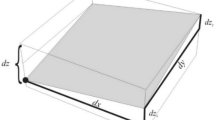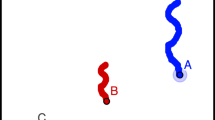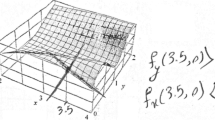Abstract
This study utilizes the Cartesian Connection and the action, process, object, and schema (APOS) theory to investigate how preservice mathematics teachers constructed and justified graphs of two-variable inequalities. The analysis shows that most teachers were not equipped with the skills and knowledge that were prerequisites for action, process, and object conceptions of two-variable inequality graphs. Many teachers used informal rules, rather than mathematical ideas such as the Cartesian Connection, to construct and/or justify inequality graphs. They also perceived inequality graphs as shapes rather than as representations based on the meaning of inequalities. I present a genetic decomposition for inequality graphs, through the concepts of variable and of parameter, as well as tasks associated with the genetic decomposition. I call for more studies on inequalities, including those relating to the implementation of the suggested genetic decomposition and tasks.






Similar content being viewed by others
References
Almog, N., & Ilany, B. S. (2012). Absolute value inequalities: High school students’ solutions and misconceptions. Educational Studies in Mathematics, 81, 347–364.
Arnon, I., Cottrill, J., Dubinsky, E., Oktaç, A., Fuentes, S. R., Trigueros, M., & Weller, K. (2014). APOS theory: A framework for research and curriculum development in mathematics education. New York, NY: Springer Science & Business Media.
Blanco, L. J., & Garrote, M. (2007). Difficulties in learning inequalities in students of the first year of preuniversity education in Spain. Eurasia Journal of Mathematics, Science & Technology Education, 3(3), 221–229.
Boero, P., & Bazzini, L. (2004). Inequalities in mathematics education: The need for complementary perspectives. In M. J. Hoines & A. B. Fuglestad (Eds.), Proceedings of the 28th Conference of the International Group for the Psychology of Mathematics Education (Vol. 1, pp. 139–143). Bergen University College.
Borowski, E. J., & Borwein, J. M. (2002). Collins dictionary of mathematics. Collins.
Carlson, M. P. (1998). A cross-sectional investigation of the development of the function concept. In J. J. Kaput, A. H. Schoenfeld, & E. Dubinsky (Eds.), Research in collegiate mathematics education, 3, CBMS issues in mathematics education (Vol. 7, pp. 114–162). Washington DC: Mathematical Association of America.
Cuoco, et al. (2013). CME project algebra 1 common core. Boston, MA: Pearson Learning Solutions.
David, M. D., Landau, M. S., McCracken, L., & Thompson, L. (2001). Pre-Algebra. Upper Saddle River, NJ: Prentice-Hall, Inc..
Dubinsky, E., Arnon, I., & Weller, K. (2013). Preservice teachers’ understanding of the relation between a fraction or integer and its decimal expansion: The case of 0.\( \overline{9} \)and 1. Canadian Journal of Science, Mathematics and Technology Education, 13(3), 232–258.
Dubinsky, E., & Harel, G. (1992). The nature of the process conception of function. In G. Harel & E. Dubinsky (Eds.), The concept of function: Aspects of epistemology and pedagogy (pp. 85–106). Washington, DC: Mathematical Association of America.
Duval, R. (2006). A cognitive analysis of problems of comprehension in a learning of mathematics. Educational Studies in Mathematics, 61(1), 103–131.
Even, R. (1998). Factors involved in linking representations of functions. The Journal of Mathematical Behavior, 17(1), 105–121.
Frost, J. (2015). Disappearing x: When solving does not mean finding the solution set. The Journal of Mathematical Behavior, 37, 1–17.
Kerslake, D. (1981). Graphs. In K. M. Hart (Ed.), Children’s understanding of mathematics (pp. 11–16). London, UK: John Murray.
Knuth, E. (2000). Student understanding of the Cartesian coordinate connection: An exploratory study. Journal for Research in Mathematics Education, 31(4), 500–508.
Kroll, R. (1986). Metacognitive analysis of the difficulties caused by intervening factors in the solution of inequalities. Doctoral dissertation, Georgia State University, Atlanta, Georgia.
Lehmann, J. (2008). Intermediate Algebra. Upper Saddle River, NJ: Prentice-Hall, Inc.
Leinhardt, G., Zaslavsky, O., & Stein, M. M. (1990). Functions, graphs, and graphing: Tasks, learning and teaching. Review of Educational Research, 60, 1–64.
Monk, G. S. (1992). Students’ understanding of a function given by a physical model. In G. Harel & E. Dubinsky (Eds.), The concept of function: Aspects of epistemology and pedagogy (pp. 175–194). Washington, DC: MAA.
Moon, K., Brenner, M. E., Jacob, B., & Okamoto, Y. (2013). Prospective secondary mathematics teachers’ understanding and cognitive difficulties in making connections among representations. Mathematical Thinking and Learning, 15(3), 201–227.
Moschkovich, J., Schoenfeld, A. H., & Arcavi, A. (1993). Aspects of understanding: On multiple perspectives and representations of linear relations, and connections among them. In T. Romberg, E. Fennema, & T. Carpenter (Eds.), Integrating research on the graphical representation of function (pp. 69–100). Hillsdale, NJ: Erlbaum.
Schreiber, I., & Tsamir, P. (2012). Different approaches to errors in classroom discussions: The case of algebraic inequalities. Investigations in Mathematics Learning, 5(1), 1–20.
Sfard, A. (1991). On the dual nature of mathematical conceptions: Reflections on processes and objects as different sides of the same coin. Educational Studies in Mathematics, 22, 1–36.
Sfard, A., & Linchevski, L. (1994). Between arithmetic and algebra: In the search of a missing link the case of equations and inequalities. Rendiconti Del Seminario Matematico, 52, 279–307.
Strauss, A. L. (1987). Qualitative analysis for social scientists. Cambridge, UK: Cambridge University Press.
Switzer, J. M. (2014). Graphing inequalities connecting meaning. The Mathematics Teacher, 107(8), 580–584.
Tall, D. O. (2004). Reflections on research and teaching of equations and inequalities. In M. J. Hoines & A. B. Fuglestad (Eds.), Proceedings of the 28th Conference of the International Group for the Psychology of Mathematics Education (vol. 1, pp. 158–161). Bergen, Norway: Bergen University College.
Thompson, P. W. (1994). Students, functions, and the undergraduate mathematics curriculum. In E. Dubinsky, A. H. Schoenfeld, & J. J. Kaput (Eds.), Research in collegiate mathematics education, 1, Issues in mathematics education (Vol. 4, pp. 21–44). Providence, RI: American Mathematical Society.
Trigueros, M., & Martinez-Planell, R. (2010). Geometrical representations in the learning of two variable functions. Educational Studies in Mathematics, 73, 3–19.
Tsamir, P., & Bazzini, L. (2004). Consistencies and inconsistencies in students’ solutions to algebraic ‘single-value’ inequalities. International Journal of Mathematical Education in Science and Technology, 35(6), 793–812.
Tsamir, P., Tirosh, D., & Almog, N. (1998), Students’ solutions of inequalities. In Olivier, A., & Newstead, K. (Eds.), Proceedings of the 22th Conference of the International Group for the Psychology of Mathematics Education, (Vol. 6, pp. 129–136). Stellenbosch, South Africa. University of Stellenbosch.
Vaiyavutjamai, P., & Clements, M. A. (2006). Effects of classroom instruction on student performance on, and understanding of, linear equation and linear inequalities. Mathematical Thinking and Learning, 8(2), 113–147.
Weber, E., & Thompson, P. W. (2014). Students’ images of two-variable functions and their graphs. Educational Studies in Mathematics, 87, 67–85.
Funding
This work was partially supported by a grant from the Spencer Foundation (Grant No. 201400165). The opinions expressed in the paper are those of the author and not those of the Foundation.
Author information
Authors and Affiliations
Corresponding author
Additional information
Publisher’s note
Springer Nature remains neutral with regard to jurisdictional claims in published maps and institutional affiliations.
Rights and permissions
About this article
Cite this article
Moon, K. New approaches for two-variable inequality graphs utilizing the Cartesian Connection and the APOS theory. Educ Stud Math 104, 351–367 (2020). https://doi.org/10.1007/s10649-020-09956-1
Published:
Issue Date:
DOI: https://doi.org/10.1007/s10649-020-09956-1




